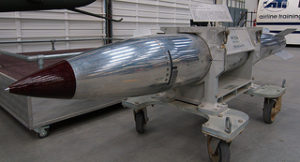In its FY14 budget request, the National Nuclear Security Administration (NNSA) asked for increased funding for nuclear weapons activities and decreased funding for nonproliferation programs. One of the biggest requested increases was for the B61 Life Extension Program (LEP), which we discussed in a previous blog. The NNSA requested $537 million in funding for the B61 LEP for FY14—a 45% increase over FY13. In committee consideration of the appropriations bill, the Senate cut $168 million from the request (with the possibility of restoring this amount if the program stays on deadline and on budget), while the full House increased funding by $24 million. These very different numbers, however, obscure the fundamental underlying agreement on the need for the NNSA to better justify its plans for an elaborate and expensive LEP for the B61, rather than a more modest option.
On the money
The Senate notes that the $369 million in funding it provided will allow continued work on the nonnuclear components of the B61 that are known to be reaching the end of their lifespans. Its cuts are meant to encourage the NNSA to reconsider the need for the much more elaborate and expensive refurbishment option that it has chosen, and to “develop a scope of work that can be successfully executed within known budget constraints.” The Senate bill expresses concern that “the NNSA’s proposed scope of work for extending the life of the B61 is not the lowest cost, lowest risk option that meets military requirements,” and that potential complications of an overly complex LEP may actually delay replacement of critical nonnuclear components.
In explaining its decision to add $24 million to the NNSA’s request, the House notes that this increase is to compensate for the discrepancy between the amount the NNSA requested for the program in FY14 and the amount that it originally indicated would be needed to keep it on track. The NNSA’s request was $24 million under the amount it originally specified, a difference it attributed to what the House calls “unspecified program efficiencies.” This refers to the NNSA’s decision to include in its budget submission anticipated savings due to “Management Efficiencies,” and to assume that these savings would allow it to carry out many of its programs with lower funding. The budget request, however, did not provide further information about how such efficiencies would be achieved, and the House expresses skepticism that they will materialize, saying that “the NNSA must have a solid basis for reductions it proposes…with a clear explanation for how those changes will impact the cost and schedule…”
The House’s decision to increase funding for the program, then, is based largely on its distrust of the NNSA’s ability to provide accurate cost and schedule estimates and to successfully manage major programs—distrust that is probably well-founded, if past experience is any guide.
The funding differences between the House and Senate actually reflect diverse approaches to the same problem: the NNSA cannot be trusted to accomplish what it claims it can for a specific amount of money. The Senate wants the NNSA to pursue a less aggressive option, while the House is providing more money up front.
Considering the Options
More important than the money issues, both houses question the NNSA’s selection of such a complex and expensive option for the B61 LEP.
The House bill includes a provision requiring the NNSA to submit a report on alternatives and certification of the affordability of the selected alternative now that the project has passed its phase 6.3 (development engineering) milestone. Somewhat more assertively, the Senate version encourages the NNSA to reconsider its selected option in favor of more realistic alternatives, as well as directing it to submit an analysis of reduced life cycle costs for the current option, including investigating whether consolidating the four existing variants of the weapon down to one would lead to savings, as the NNSA has stated.
Neither side of Congress, it seems, is particularly pleased with how the NNSA arrived at its decision to pursue a life extension program that the DOD estimates could cost $10 billion.
And not everyone is happy that House appropriators decided to increase funding for the B61. When the committee’s bill came to the House floor, several members offered an amendment to reduce funding for the B61 by $24 million, back to the level requested by the NNSA. Although it narrowly failed by a vote of 196-227, the amendment gained bipartisan support, with 166 Democrats and 30 Republicans voting in favor. Such broad support for a measure to cut funding for a nuclear weapons program is rare in Congress, especially in the House, and signals potential for a compromise to bring the final appropriation closer to the Senate’s number.
Senate appropriators also took aim at the program from another angle, by cutting nearly all the funding the Air Force requested for a new tail kit for the bomb. Out of the requested $68 million for the tail kit program, the Senate approved only $6 million—a cut of more than 90 percent. The new tail kit, which falls under the DOD’s budget, rather than the NNSA’s, would increase the accuracy of the bomb. It is only necessary, however, if the NNSA continues with the elaborate version of its LEP plan, which would consolidate four existing variants of the bomb down to a single new model, the B61-12. By cutting funding for the tail kit, the Senate also slows momentum toward the more complex version of the LEP.
Despite some differences in their approaches, the underlying message coming through loud and clear from both houses of Congress on the B61 is their desire to put the NNSA on notice. This is a good thing. Right now, huge cost increases and schedule slips are the norm, not the exception, for major NNSA programs. Recent examples include the Chemistry and Metallurgy Research Replacement- Nuclear Facility at Los Alamos and the Pit Disassembly and Conversion Facility at Savannah River, both of which were canceled after years of work and millions of taxpayer dollars when the NNSA realized that their functions could be accomplished more economically and quickly by using existing facilities. The Mixed Oxide (MOX) Fuel Fabrication Facility, also at Savannah River, may be next in line to meet a similar fate.
Rather than accepting the NNSA’s approach to the B61 at face value, Congress is frustrated and trying to force greater transparency on the part of the agency, encouraging a “measure twice cut once” philosophy on major projects. (In the case of the Uranium Processing Facility (UPF), a literal interpretation of this philosophy would have been helpful. The UPF’s design was nearly complete, and hundreds of millions of dollars had already been spent when the NNSA discovered a “space/fit issue”—the building as designed would not have enough space to fit all the necessary equipment. The NNSA now estimates that correcting this error will cost taxpayers over $500 million.)
How the House and Senate differences in funding will be resolved is unclear, as the debates about funding for the entire government continue to get bogged down in largely political issues. What is clear is that Congress is tired of the NNSA producing slipshod estimates for how much things cost, how long they will take, and most importantly, what exactly is required to get the job done.

